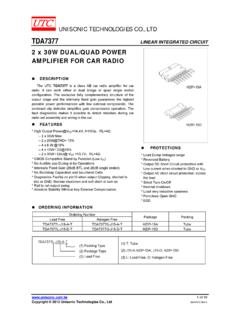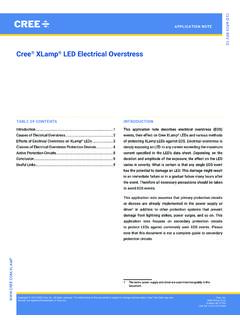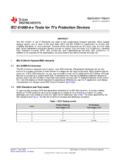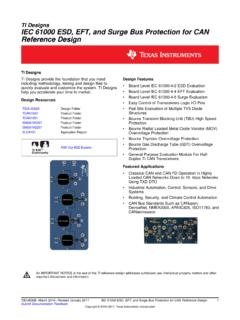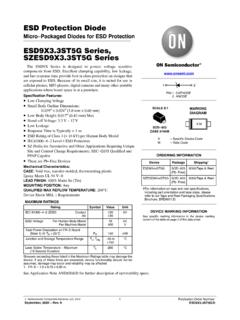Transcription of AN-727 APPLICATION NOTE - Analog Devices
1 AN-727 APPLICATION NOTEOne Technology Way Box 9106 Norwood, MA 02062-9106 Tel: 781/329-4700 Fax: 781/326-8703 RS- 485 bus standard is one of the most widely used physical layer bus designs. The RS- 485 standard is speci-fied to drive up to 32 driver/receiver pairs. Although no maximum cable length is specified, lengths of 4000 meters are possible. The versatility of the RS - 485 makes this design popular for a wide range of applications , espe-cially intersystem connections over long distances. Because the RS- 485 system is typically used to connect multiple systems, and is often run over very long cable distances, isolation between the bus and each system connected is critical. Digital isolation provides crucial isolation and protection from overvoltage transients between the RS - 485 cable network and the systems connected to it. Digital isolation also eliminates ground loops in the RS - 485 network.
2 Digitally isolating the RS - 485 bus from each system connected to the bus reduces signal distortion and errors, and provides sys-tem and component protection from system and bus voltage and ground mismatches. The intention of this APPLICATION note is to give the user a brief overview of the RS- 485 system physical layer, as well as an understanding of why isolation is so impor-tant to the system. This APPLICATION note details how to implement isolation in an RS- 485 system using Analog Devices iCoupler products. RS-485 OVERVIEWRS- 485 is more properly known as EIA/TIA485, but is commonly referred to by the older Recommended Standard 485 designation. The RS - 485 specification defines the physical layer only. Signal protocol is defined by the user, or standards that define the protocol, and specify RS- 485 for the physical Isolation in RS-485 Applicationsby Sean ClarkThe RS- 485 is found in products ranging from industrial sys-tems to computers.
3 Examples of protocols that specify this bus design include the SCIS2 and SCIS3 (Small Computer Systems Interface) busses, and the PROFIBUS (Process Field Bus) high performance lengths are dependent upon system data speed requirements. Examples of data rate and length combina-tions vary from 200 kbps at 1200 meters, to 12 Mbps at 100 meters for the PROFIBUS high performance RS- 485 bus. Note that the PROFIBUS also requires special high performance RS- 485 drivers. The RS- 485 uses balanced differential signaling. RS- 485 drivers send the data signal across two output lines. The receiver determines the logic state by comparing these two input signals to each other, rather than to a ground reference. The receiver looks for a greater than 200 mV difference between the A and B inputs for a valid logic level. The RS- 485 drivers and receivers contain differ-ential amplifiers and their circuits steer current between the two differential signal lines.
4 The use of differential signaling imbues the system with a high level of noise immunity when compared to single-ended drive schemes, such as that used in the RS-232 specification. All RS - 485 drivers also include an enable function to allow the drivers to be placed in high impedance state. The enable function allows multiple drivers to share one bus and prevents bus contention problems. The driver enable feature and the software protocol define the arbitration procedure for line sharing between the driv-ers. The software protocol arbitrates between the drivers, keeping all but one at a time in the inactive state. This arbitration allows line sharing by up to 32 0 2 AN-727 3 AN-7272-WIRE AND 4-WIRE CONFIGURATIONSRS- 485 is specified to support up to 32 drivers and 32 receivers in a half- duplex, bidirectional, 2-wire, multi-drop configuration on one bus. Each node on the line contains a receiver and a driver.
5 In this configuration, all receiver and driver pairs share the same set of two differential signal lines. (Figure 1) The 2-wire system can be installed using just one twisted pair cable. This design simplifies installation and keeps costs down. However, the design requires that all drivers share the line, limiting maximum data throughput 4-wire RS-485 full-duplex design is also possible. (Figure 2). In the 4-wire configuration, one node is the master node that communicates to all other nodes. The slave nodes communicate only with the master node. Although more complex, this design greatly improves data throughput AND BIASING NETWORKST ermination is used to match the line end nodes to the impedance value of the transmission line, reducing or eliminating reflections. However, termination also increases the line load. Also, since the termination is connected only to the end nodes on the line, this can make system modifications more difficult.
6 Termination is needed in high data rate and long line applications . Although various termination designs can be used, the most common is a resistor connected in parallel across the differential lines (Figures 1 and 2). Every stub line adds capacitance and can generate reflections and disruptions to the signal on the RS- 485 bus. To minimize these effects, stub connections to all receivers and transmitters on the line should be as short as AT LINE ENDS ONLYTERMINATION AT LINE ENDS ONLYF igure 1. RS-485 2-Wire Multidrop, Half-Duplex NetworkENABLETXRXTERMINATION AT LINE ENDS ONLYTERMINATION AT LINE ENDS ONLYENABLERXTXENABLETXRXSLAVESLAVEENABLE SLAVETXRXMASTERF igure 2. RS-485 4-Wire Multidrop, Full-Duplex NetworkREV. 0 REV. 0 2 AN-727 3 AN-727A resistor biasing network, (also known as a fail-safe, or idle line network) is necessary if the network is placed in an idle condition where all drivers are in a high imped-ance state (Figure 3).
7 The biasing resistors ensure that all receiver A inputs are 200 mV above the B inputs when no driver signal is pres-ent. This prevents receivers from going into oscillations. Oscillations can appear on receiver outputs as erroneous data. The biasing network does add loading to a system, and values are in direct relation to the specific system design (+5V)Figure 3. RS-485 Fail-Safe Biasing Network SYSTEM ISOLATION OVERVIEWU nwanted currents and voltages on a cable bus connect-ing multiple systems have the potential to cause severe problems. High voltages and currents can destroy com-ponents connected to the bus. These unwanted voltages and currents come primarily from two sources: ground loops and electrical line surges. Ground loops occur when a bus or system utilizes multiple ground paths. It cannot be assumed that two system grounds connected to the bus and separated by hundreds or thousands of meters will be at the same potential.
8 Because these grounds are unlikely to be at the same potential, current will flow between these points. This unintended current flow can damage or destroy components. Electrical surges can be caused by many sources, these surges are the result of currents coupled onto cable lines through induction. Long cable lines in industrial environments are especially susceptible to this phe-nomena. The operation of electric motors, in particular, causes rapid changes in the ground potential. These changes can generate a current flow through any nearby lines to equalize the ground potential. Other induction surge sources include electrostatic discharge (ESD) and lightning strikes. These induced surges can result in hundreds, or even thousands of volts of potential on the line, and manifest themselves as transient current and voltage surges. Thus, a remote node may receive a 5 V switching signal superimposed on a high voltage level with respect to the local ground.
9 These uncontrolled voltages and cur-rents can corrupt the signal, and can be catastrophic to the device and system, causing damage or destruction of the components connected to the bus, and resulting in system failure. RS - 485 systems that run over long distances and connect multiple systems are especially susceptible to these events. To protect against this potentially destructive energy, all Devices on the bus, and systems connected to the bus, must be referenced to only one ground. Isolating the RS- 485 system Devices from each of the systems con-nected to the bus prevents ground loops and electrical surges from destroying circuits. Isolation prevents ground loops because each system connected to RS- 485 cable bus, and each RS- 485 cir-cuit, has a separate and isolated ground. By referencing each RS- 485 circuit only to one ground, ground loops are eliminated. Isolation also allows the RS- 485 circuit reference volt-age levels to rise and fall with any surges that appear on the cable line.
10 Allowing the circuit voltage reference to move with surges, rather than being clamped to a fixed ground, prevents Devices from being damaged or destroyed. To accomplish system isolation, both the RS - 485 signal lines and power supplies must be isolated. Power isola-tion is obtained through the use of an isolated dc to dc power supply. Signal isolation is typically accomplished with optocouplers, or with Analog Device s innovative 0 REV. 0 4 AN-727 5 AN-727 ISOLATION IMPLEMENTATIONThe implementation of isolation is not overly complex. However, the designer must consider several important factors when implementing the isolation digital isolators do not support the RS- 485 stan-dard, it is not possible to insert a digital isolator between the RS- 485 receivers and drivers, and the RS- 485 cable. Theoretically, transformers could be used to supply isolation at that location. However, the slow speeds of the bus would require large transformers, making this solution impractical.











